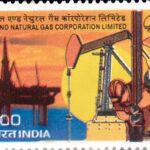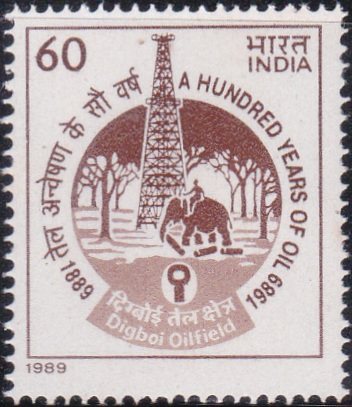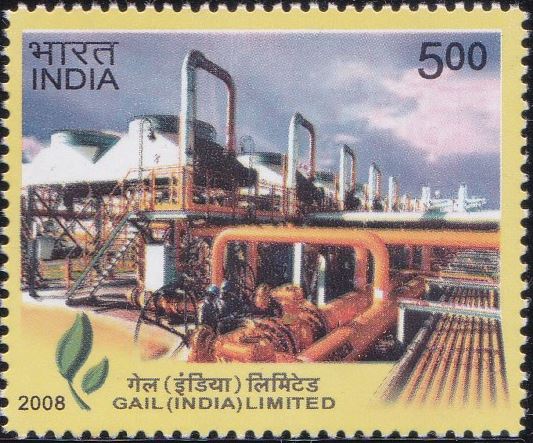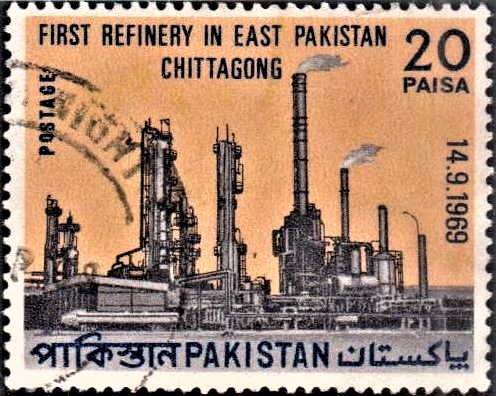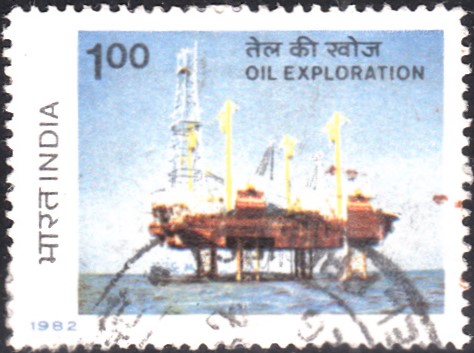
India on Oil Exploration 1982
A commemorative postage stamp on the 25th Anniversary of Oil and Natural Gas Corporation Limited (ONGC), India‘s largest oil and gas exploration and production company :
 Issued by India
Issued by India
Issued on Aug 14, 1982
Issued for : The Indian Posts and Telegraphs Department is happy to issue a special stamp on ‘Oil Exploration‘.
Description of Designs : The stamp depicts offshore jack-up drilling rig “Sagar Samrat“. The first day cover shows onshore drilling rig in the Eastern Region. Cancellation has been designed by Charanjit Lal.
Type : Stamp, Postal Used
Colour : Multicolour
Denomination : 100 Paise
Overall size : 3.91 X 2.90 cms.
Printing size : 3.55 X 2.54 cms.
Perforation : 13 x 13
Paper : Unwatermarked adhesive stamp paper
Number printed : 20,00,000
Number per issue sheet : 35
Printing process : Photogravure
Printed at : India Security Press
About :
- Search for oil began in India as early as in 1866 in the Upper Region of Assam. It was, however, only after independence that a systematic oil exploration programme covering the entire country was taken up with earnestness.
- Oil was discovered at Makum near Margherita at a depth of 36 metres as far back as in 1867 and later on at Borbhil now known as Digboi in 1890. After a considerable lapse of time, the Burma Oil Company succeeded in finding oil in Naharkatiya and Moran areas in Assam in 1953 and 1957 respectively. Subsequently, the Government of India joined hands with Burma Oil Company in 1959 and formed an exploration company called ‘Oil India Limited‘ on 50:50 partnership. Exploration was also carried out in West Bengal by the Government of India in association with the then Standard Vacuum Oil Company of USA in 1953. After drilling 10 wells in this area, which proved dry, the Standard Vacuum Oil Company gave up further efforts.
- In 1954, Government of India decided to set up a petroleum exploration division in the Geological Survey of India which evolved into the present Oil & Natural Gas Commission on August 14, 1956. After the formation of ONGC, an extensive programme for exploration was taken up in hand, covering the entire country.
- India has a sedimentary area of about 1.4 million sq-kms. In the offshore, it is 390 thousand sq-kms. upto the continental shelf of 200 metres. On the continental slope there exists another 4 lakh kms. of sedimentary area.
- Oil was first struck by ONGC at Cambay in 1958 and later on at Ankleshwar in 1960. Starting with 100 tonnes per day, annual production of crude onshore today stands at 14250 tonnes per day (5.2 million metric tonnes per annum) and gas 1.968 million cubic metres per day. The associated and free natural gas from Gujarat fields has provided great impetus to the industrial growth of Gujarat. Two major thermal power stations, a large sized refinery, a giant fertilizer complex and vast petrochemical industry near Baroda in Gujarat are based on ONGC’s supplies of natural gas and crude oil. In the Eastern Region, crude oil is supplied to the Gauhati and Barauni refineries and gas to tea estates and Assam State Electricity Board.
- However, in the recent years, it is the offshore drilling which has prominently projected itself. The development of Bombay High was conceived in various phases which were followed under a time-bound programme. Starting with 2 million tonnes of Oil production in 1975, it is planned to produce 12 million tonnes of crude oil in the current year. Further a 4 million cubic metre per day capacity gas fractionating plant alongwith LPG extraction facility for 198,000 tonnes per annum, and a crude stabilisation plant were completed by March, 1981.
- India‘s consumption of oil was around 2.7 million tonnes in 1948 and indigenous production mainly from Assam region was around 0.25 million tonnes. While the consumption pattern of petroleum has been steadily increasing in India the exploration and production activities have also been increased at a constant pace. With the production level of 17.91 million tonnes of crude oil by the ONGC and 3.04 million tonnes of Oil India, the country is able to match indigenously 66% of the present consumption level.
- With the accelerated effort of Oil production the Country is poised for achieving self-sufficiency in the years to come.
- Text by Courtesy : Oil and Natural Gas Commission.


